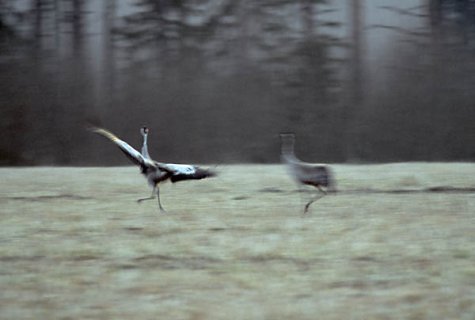Cranes arriving
Photo: Arne Ader
Nature sound: Veljo Runnel
Translation: Liis
Crane dance
Nature sound HERE
Common crane; Eurasian crane Sookurg
Small groups of cranes arrived already in March. The greater part of the birds are arriving now in larger flocks, of about twenty birds. The spring flocks of migrants are much smaller than the autumn crane triangles.
The long-lived birds begin their nest life late too. Young birds form pairs already on the wintering grounds at the age of three and in the first summer together they occupy a suitable territory. Usually they will not produce an egg clutch then. In the fourth-fifth spring the cranes are sufficiently mature and will get offspring.
The crane dance is a peculiar show, difficult to describe; it must be seen (see Arne’s photo). The kru-kruu is a familiar sound to all moving about in nature, and the crane pairs call in a duet – one in the pair calls, the other one answers at once.
The arriving birds occupy an area suited for their nesting – it is certainly watery, in an open or shrubby bog, on water-logged boggy shores of lakes, on seashore meadows - and always where foxes and raccoon dogs will not go. The nest is a simple mound made of the materials at hand: clods of earth, withered leaves and grass, reeds etc. The majority of the nesters begin the egg-laying in the second half of April. The female usually lays two large greenish eggs with a red pattern and at once begins to incubate them. She is often relieved by the male. On leaving the nest the eggs are hidden in straws. During the nesting period the birds are quiet and secretive, only in early mornings we can hear the nesting pair’s loud duet .









